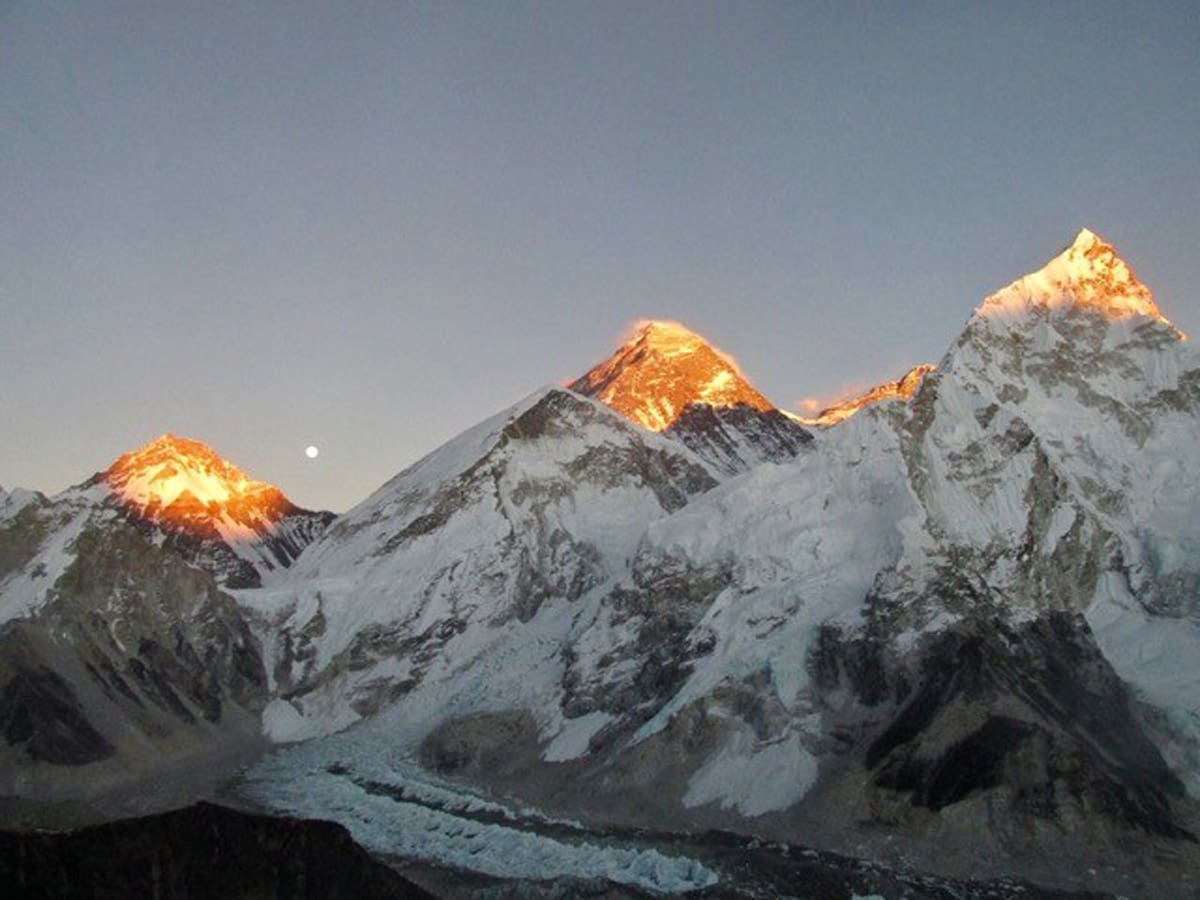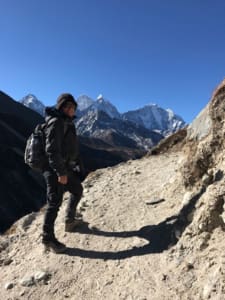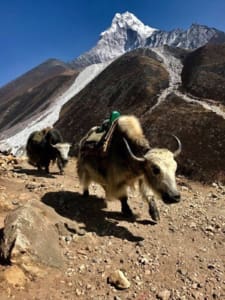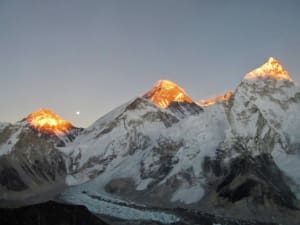Domesticated Yaks, used to carry supplies and also ridden by mountaineers. The Sun bouncing off the Himalayan peaks and Mandy ascending the mountain range.
Asked why this particular trip Mandy Bourlet said, “Having long held a desire to return to the Himalayas after travelling along the Silk Road into Pakistan, this trip attracted me because to be eligible to do the trek each participant had to raise at least $4,000 for Amnesty International. I am passionate about human rights, here in Australia from children’s rights, women and men’s equal rights to the rights of people all around the world. I raised $4,600.00. The sky is perfectly blue above a cloud blanket lying over the mountain range with only the highest peaks of the Himalayas visible from the twin turbo plane, I guess one of them must be Everest. [MT Everest is the highest in the world at a staggering 8,848 m.] I am sitting beneath the wing, a couple of seats from the cockpit, all 19 seats are filled, trekkers with their packs on their laps and stacked in the isle, there is no room to move but the air hostess expertly weaved through to hand out complimentary mints and cotton balls for our ears.
As we approach the short and steep airstrip I feel a rush of excitement, apprehension and anxiety; after all, it is the world’s most dangerous airport. Nestled 2,860m above sea level (Mt Kosciusko peak is 2,280m) the length of the Lukla’s airstrip is 527m, one end is a cliff and the other a wall of mountain rock. Pilots have little room for mistakes and must tackle changing air pressure, high winds and varying visibility. I am about to experience a once in a lifetime event and the fear of uncertainty has heightened my senses, every part of me is in this moment. The landing is smooth and very quick. As I step out of the plane the cold air, the noise of the aircraft, ours landing, another preparing to leave and one with passengers gathering bags in front of us jolts me into reality. Once off the tarmac I have a chance to take in the surroundings, looking back at the runway, carved into the mountain, the end dropping away so suddenly into the valley below, I marvel at the skill the pilots need to navigate this.
I crane my neck to see the top of the mountains surrounding this small airport, I am overcome with emotion, the immensity, beauty and the serenity take my breath away. These Mountains have an intense stillness of being. Now to meet the local Nepalese guides who will take me by foot, the round trip, 130km to base camp. The trek was physically easier than I had imagined, but mentally more difficult as the altitude was a bigger factor than I had allowed for. Each day was a full day of walking, the majority extremely uphill, then extremely downhill and rocky under foot. The pace was steady as the best way to deal with altitude is to walk slow and take your time. I slipped on loose downhill gravel and tore my Achilles tendon in my heel on the 6th day (14 left to walk). I started having altitude sickness at 4,000m which included a headache, loss of appetite, nausea, fatigue, racing pulse and difficulty breathing.
By the time I had reached the altitude of 5,000m my symptoms became worse and I was vomiting, had a horrendous headache, extreme fatigue, and slight hallucinations. During the time I was trekking, I heard of 8 people who had to be evacuated due to pulmonary oedema and cerebral oedema [excess fluid in tissues] and the day I returned to Australia a Melbourne man who was a couple days behind me on the trek died after making it to base camp. He was on his way down when he died from pulmonary oedema. The coldest temperature was minus 20 overnight and minus 12 during the day but sunny every day – the guides said we had good karma and the week after I arrived back to Australia there was hip deep snow.
The water at the teahouses where we overnighted, was directly from the river and streams, so snow water and it was freezing, no hot water after 4 000m, no trees after 400m either so the fire in the communal dining room was burning yak dung. The rooms were only plywood with a wire bed frame. The local people were the most beautiful people I have met, so welcoming, so friendly and for the little they have they are always positive. They are tough and carry very heavy loads up and down the mountain range as the only way in for supplies and goods is by delivery to Lukla Airport and then carried by foot or yak up the mountains. Think about that for a moment, what things do we use every day? Building supplies, housing white goods, groceries, absolutely everything.
I stayed in tea houses each night, the locals who owned them cooked for us. I ate vegetarian while there, as any meat was brought in from Kathmandu and carried up the mountain on someone’s back without refrigeration, so vegetable momos – fried or steamed vegetable dumplings which were delicious, vegie fried noddles, chapati and boiled eggs were my diet for 20 days. The teahouses were very basic but comfortable – lots of fun sitting around the yak poo fire chatting. [Google ‘Tea houses Nepal’ for more information.] I carried all the things I needed for the day, all my water, the higher you climb the more water recommended, around 6-7L per day, my snacks for the day and clothing, toilet paper, etc. I was there just at the beginning of climbing season so no foreign climbers were present and the Nepalese were only starting to prepare for climbing season. I met a couple of Nepalese who had climbed Everest as ‘Sherpas”.
One man had climbed her 7 times and was on his way for the 8th time. I spoke to him and he was so interesting to talk to. He was one of the men who prepare for climbing season, who go ahead and secure the ladders over the ice falls and ropes across the glaciers, set up the camps ready for when the paying foreign climbers come. He, and others, seem to become addicted to climbing Everest; they can be paid an equivalent of a year’s wage for assisting foreign climbers. Families of these men don’t like them doing this work as it is very dangerous and they believe Everest (Chomolungma) to be Mother of Earth and sacred and it is like we are treading on her. My Himalayan adventure has changed my perspective on life, as all challenges do; for me it’s all about the journey and not the destination, which is how I wish to live my life.”






